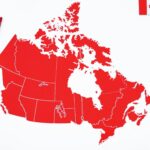In a significant development for Canadian immigration hopefuls, Immigration, Refugees and Citizenship Canada (IRCC) has once again demonstrated its commitment to provincial-level immigration streams. The latest Express Entry draw exclusively targeted candidates with a Provincial Nominee Program (PNP) nomination, reinforcing the immense value of securing a provincial endorsement on the path to permanent residence. This targeted approach underscores a pivotal trend in Canada’s immigration strategy, prioritizing candidates who have already been selected by a province or territory to meet specific regional economic and demographic needs.
Table of Contents
- A Deep Dive into the Latest Express Entry PNP Draw Results
- The Pivotal Role of a Provincial Nomination in Your Canadian Immigration Journey
- Analyzing Recent Express Entry Trends: What Do These Draws Signify?
- Essential Takeaways for Aspiring Canadian Immigrants
- Frequently Asked Questions
A Deep Dive into the Latest Express Entry PNP Draw Results
In this most recent invitation round, IRCC issued 1,186 Invitations to Apply (ITAs) for permanent residence. The draw was program-specific, focusing solely on candidates within the Express Entry pool who had previously received a nomination from a Canadian province or territory. The minimum Comprehensive Ranking System (CRS) score required for this draw was 776. At first glance, a CRS score of 776 might seem extraordinarily high compared to general or category-based selection rounds, which often feature scores in the 400s or 500s. However, this elevated threshold is a direct and expected consequence of the PNP stream. Candidates who successfully secure a provincial nomination are automatically awarded an additional 600 points to their existing CRS score. Therefore, a candidate needed a base score of only 176 before receiving the nomination to meet this draw’s cut-off. This highlights the transformative power of a provincial nomination, effectively guaranteeing an ITA in a subsequent PNP-specific draw. This focused draw demonstrates IRCC’s continued collaboration with provinces to address localized labour market shortages and distribute the benefits of immigration across the country, moving beyond major metropolitan hubs.
The Pivotal Role of a Provincial Nomination in Your Canadian Immigration Journey
For many aspiring immigrants, the Provincial Nominee Program (PNP) represents the most strategic and powerful pathway to achieving permanent residence in Canada. The system is designed as a partnership between the federal government and individual provinces and territories, allowing them to nominate individuals who have the specific skills, education, and work experience needed to contribute to their local economy. When a candidate in the Express Entry pool receives a provincial nomination, their application is significantly bolstered. The 600-point bonus awarded for a nomination is a game-changer, elevating their CRS score far above most other candidates and making an Invitation to Apply (ITA) virtually certain. Each province has multiple PNP streams, often tailored to specific occupations in demand, graduates of local post-secondary institutions, or entrepreneurs. For example, provinces like British Columbia and Ontario have popular ‘Tech’ streams to attract skilled tech workers, while others like Saskatchewan and Alberta have streams focused on agriculture or long-haul truck drivers. The first step for a candidate is to create an Express Entry profile and then explore the various PNP streams to see where their qualifications align. Securing a nomination is a two-step process: first, applying to the province, and upon approval, accepting the nomination in the federal Express Entry system to receive the critical 600-point boost.
Analyzing Recent Express Entry Trends: What Do These Draws Signify?
The landscape of Express Entry has undergone a profound transformation over the past year. While all-program draws, which invite candidates from all three federal programs (Federal Skilled Worker, Canadian Experience Class, and Federal Skilled Trades), were once the norm, IRCC is now increasingly utilizing a more targeted approach. This shift was formalized with the introduction of category-based selection draws. These draws invite candidates with specific attributes, such as strong French-language proficiency or work experience in high-demand sectors like healthcare, STEM (Science, Technology, Engineering, and Math), trades, transport, and agriculture. The continued frequency of PNP-specific draws fits perfectly within this broader strategy. It allows IRCC to be more nimble and responsive to Canada’s evolving economic needs. By alternating between all-program draws, category-based selections, and PNP-specific rounds, the government can balance its overall immigration targets with the acute labour shortages identified by both federal and provincial bodies. For candidates, this means that a high CRS score is no longer the only path to success. A strategic approach involves not only maximizing one’s human capital points but also identifying if one’s profile aligns with a specific provincial need or a federal category, thereby opening up multiple avenues for receiving a coveted Invitation to Apply.
Essential Takeaways for Aspiring Canadian Immigrants
Understanding the nuances of the Express Entry system is crucial for any prospective applicant. This latest PNP-specific draw provides several key insights that can help shape an effective immigration strategy. Candidates in the pool should consider these points carefully as they plan their next steps.
- Provincial Nomination is a Golden Ticket: The 600-point bonus for a PNP nomination is the single most valuable factor within the CRS. Actively researching and applying for relevant PNP streams should be a top priority for candidates who may not meet the cut-off for general draws.
- A Lower Base Score Can Still Succeed: As this draw demonstrates, a base CRS score of 176 was sufficient for an ITA, provided the candidate had a provincial nomination. This should offer encouragement to those with lower initial scores to pursue the PNP route.
- Targeted Draws Are the New Reality: Relying solely on all-program draws is no longer a viable strategy. Candidates must assess their eligibility for category-based selections (e.g., healthcare, STEM, French proficiency) and PNP streams to maximize their chances of being invited.
- Keep Your Profile Updated: Ensure your Express Entry profile is always current with your latest work experience, language test results, and educational credentials. Many PNPs require an active and accurate Express Entry profile to be eligible for consideration.
Frequently Asked Questions
What is a Provincial Nominee Program (PNP) draw?
A PNP draw is a specific type of Express Entry invitation round where Immigration, Refugees and Citizenship Canada (IRCC) only invites candidates who have already received a nomination from a Canadian province or territory. These candidates have been identified by a province as having the skills and experience needed to fill local labour market gaps.
Why was the CRS score of 776 so high in this Express Entry draw?
The Comprehensive Ranking System (CRS) cut-off score was 776 because this draw was exclusively for PNP candidates. Upon receiving a provincial nomination, a candidate is awarded an additional 600 points to their base CRS score. This means a candidate only needed a score of 176 before the nomination to be invited in this round.
How can I get a provincial nomination?
To get a provincial nomination, you must first identify a PNP stream in a province or territory for which you are eligible. Each province has various streams targeting specific skills, occupations, or connections to the province. You must apply directly to the province’s immigration authority, and if successful, you will receive a nomination certificate to add to your federal Express Entry profile.
What are category-based selection draws?
Category-based selection draws are a newer type of Express Entry draw that targets candidates with specific work experience in high-demand sectors (like healthcare, STEM, or trades) or those with strong French-language abilities. These draws are designed to help Canada address specific economic priorities and labour shortages across the country.
Talk to us to find out more. ->
The content above is not intended to provide legal advice or opinions of any kind and may not be used for professional or commercial purposes.







